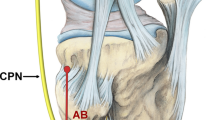Abstract
Purpose
The aim of this study was to clarify the origins of the lumbricals of the foot toward a better understanding of its precise action in the gait.
Methods
The lumbricals in the foot were investigated in 66 specimens of embalmed Korean adult cadavers.
Results
The first lumbrical arose as two muscle bellies from both the tendon of the FDL and the tendinous slip of the FHL in 83.3 %, and as one muscle belly from the tendon of the FDL or the tendinous slip of the FHL in 16.7 %. These two muscle bellies subsequently merged to form the muscle belly of the first lumbrical. The second lumbrical arose from the tendinous slips of the FHL for the second and third toes as well as the tendon of the FDL in all specimens. The third lumbrical arose from the tendinous slips of the FHL for the third and fourth toes in 69.7 %, and the fourth lumbrical arose from the tendinous slip of the FHL for the fourth toe in 18.2 %. Some deep muscle fibers of the fourth lumbrical arose from the tendinous slip of the FHL for the second toe in 4.5 %, for the third toe in 28.8 %, and for the fourth toe in 15.2 %.
Conclusions
The results of this study constitute new anatomical knowledge regarding the origin of the lumbricals, and provide insight into their specific role in production of gait. These findings will be useful for various types of surgery, biomechanics research, and rehabilitation programs.



Similar content being viewed by others
References
Backhouse KM, Catton WT (1954) An experimental study of the functions of the lumbrical muscles in the human hand. J Anat 88:133–141
Goldmann JP, Sanno M, Willwacher S, Heinrich K, Brüggemann GP (2013) The potential of toe flexor muscles to enhance performance. J Sports Sci 31:424–433
Hollinshead WH (1982) Anatomy for surgeons: the back and limbs, vol 3, 3rd edn. Harper, New York, p 841
Hur MS, Kim JH, Woo JS, Choi BY, Kim HJ, Lee KS (2011) An anatomic study of the quadratus plantae in relation to tendinous slips of the flexor hallucis longus for gait analysis. Clin Anat 24:768–773
Jenkins DB (2009) Hollinshead’s functional anatomy of the limbs and back, 9th edn. Saunders, Philadelphia, pp 332–355
Kistemaker DA, Van Soest AJ, Wong JD, Kurtzer I, Gribble PL (2013) Control of position and movement is simplified by combined muscle spindle and Golgi tendon organ feedback. J Neurophysiol 109:1126–1139
Koizumi M, Kawai K, Honma S, Kodama K (2002) Anomalous lumbrical muscles arising from the deep surface of flexor digitorum superficialis muscles in man. Ann Anat 184:387–392
Kura H, Luo ZP, Kitaoka HB, An KN (1997) Quantitative analysis of the intrinsic muscles of the foot. Anat Rec 249:143–151
Macalister A (1875) Additional observations on muscular anomalies in human anatomy (third series), with a catalogue of the principal muscular variations hitherto published. Trans Roy Irish Acad Sci 25:1–134
Mehta HJ, Gardner WU (1961) A study of lumbrical muscles in the human hand. Am J Anat 109:227–238
Morris H (1947) Morris’ human anatomy: a complete systematic treatise, 10th edn. Blakiston Co, Philadelphia, p 563
Nayak SR, Rathan R, Chauhan R, Krishnamurthy A, Prabhu LV (2008) An additional muscle belly of the first lumbrical muscle. Cases J 18(1):103
Palti R, Vigler M (2012) Anatomy and function of lumbrical muscles. Hand Clin 28:13–17
Payne RC, Crompton RH, Isler K, Savage R, Vereecke EE, Günther MM, Thorpe SK, D’Août K (2006) Morphological analysis of the hindlimb in apes and humans. I. Muscle architecture. J Anat 208:709–724
Potu BK, Gorantla VR, Rao MS, Bhat KM, Vollala VR, Pulakunta T, Nayak SR (2008) Anomalous origin of the lumbrical muscles: a study on South Indian cadavers. Morphologie 92:87–89
Rabischong P (1962) L’innervation proprioceptive des muscles lombricaux de la main chez l’homme. Rev Chir Orth 48:234–245
Roy S, Mehta V, Arora J, Dhuria R, Suri R, Rath G, Das S (2011) An unusual bifid origin of 1st lumbrical muscle of hand: anatomical and clinical perspectives. Clin Ter 162:249–250
Sinnatamby CS (2011) Last’s anatomy: regional and applied, 12th edn. Churchill Livingstone, New York
Standring S (2008) Gray’s anatomy, 40th edn. Elsevier, New York
Thomas DH, Long C 2nd, Landsmeer JM (1968) Biomechanical considerations of lumbricalis behavior in the human finger. J Biomech 1:107–115
Wang K, McGlinn EP, Chung KC (2014) A biomechanical and evolutionary perspective on the function of the lumbrical muscle. J Hand Surg Am 39:149–155
Wolpert DM, Ghahramani Z, Jordan MI (1995) An internal model for sensorimotor integration. Science 29(269):1880–1882
Wolpert DM, Miall RC, Kawato M (1998) Internal models in the cerebellum. Trends Cogn Sci 2:338–347
Wood J (1868) Variations in human myology. Proc Roy Soc Lond 15:518–846
Woodburne RT, Burkel WE (1994) Essentials of human anatomy, 9th edn. Oxford University Press, New York
Acknowledgments
This work was supported by research fund of Catholic Kwandong University (CKURF-201406610001).
Conflict of interest
The authors declare that they have no conflict of interest.
Author information
Authors and Affiliations
Corresponding author
Rights and permissions
About this article
Cite this article
Hur, MS., Kim, JH., Gil, YC. et al. New insights into the origin of the lumbrical muscles of the foot: tendinous slip of the flexor hallucis longus muscle. Surg Radiol Anat 37, 1161–1167 (2015). https://doi.org/10.1007/s00276-015-1488-6
Received:
Accepted:
Published:
Issue Date:
DOI: https://doi.org/10.1007/s00276-015-1488-6




